Sarah Gray's Blog
October 13, 2021
Racontesse Journal: Mercurial Delights
… was a phrase I was both charmed and delighted with. It was a recent remark made by my new publisher, Mercuria Press at a book trade show in the US.
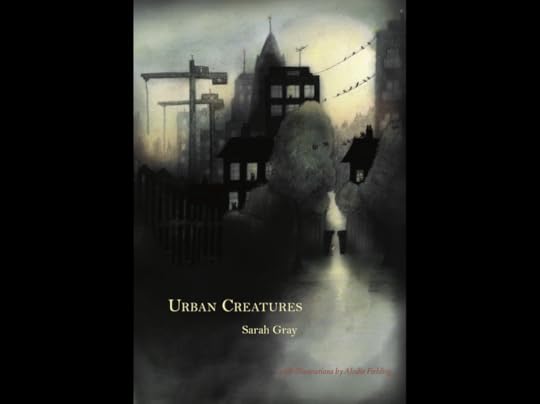
Illustration © Alodie Fielding
Negotiations have ended, the contracts are signed and the new edition of Urban Creatures – my collection of dark tales - will be ready for pre-order before Christmas, available in Spring 2022. US based, Mercuria Press is an imprint of Chin Music Press and has bought the North American and world-wide rights to all three of my collections. Their publishing ethos is one of beautiful books that enrapture the senses and it aligns with my own – that is to produce wonderful literature which goes hand-in-hand with sumptuous artwork. Carla Girard at Mercuria Press has elevated my relationship with the Collection’s artist, Alodie Fielding. Accordingly, I’m pleased to announce Alodie’s name appears on the front cover of Urban Creatures.
The forthcoming edition includes new versions of the illustrations and, I can attest that, they are gorgeous. Having displayed a poster of the cover at a recent trade show, Carla was delighted to tell me that people were drawn to it ‘like bees to a dusky flower’ and this gave her a chance to share our excitement about the book. This is such a perfect partnership and I’m grateful to Katie Isbester at Claret Press for reaching her goal of passing my work on to achieve a wider audience.
If you’ve kept an eye on this blog before – then keep on peeping to uncover more…
Sarah Gray
Oct 2021
May 17, 2021
Fireside Reflections: The Lady of the House of Love by Angela Carter
Fancy a bite?

The Supper Club is here to convince readers that the short story is a mighty feast, imbued with complex flavours and the third sitting was a Gothic banquet.
Thank you to everyone who came to sup and share bonhomie at our table. Apologies for the sound issues during the first 10 minutes and we hope it didn't ruin your overall enjoyment of the event. We appreciate and agree that the balance of biographical information and story detail was a little out of kilter – in the future, we will be sure to keep the short story as the star.
For those of you who couldn't join in or just want more, come sit by the fire with us….
My first encounter with the Queen of the vampires was one of confusion. There was a damsel in distress dreaming of a different life and there was a hero. A hero who was everything a hero is supposed to be, young, strong and surrounded with a halo of golden sunlight.
Where then, was my happily ever after?

Whilst reading Edmund Gordon's biography of Angela Carter, The Invention of Angela Carter: A Biography, the ideas felt familiar almost like waking up memories from my childhood. It's only as I have studied and read and matured that I realised I was (old habits die hard) as indoctrinated by the patriarchy as the next woman. Now I understand that we, as women can create our own happy endings, self save and carve our own path. And for me, Angela Carter's, The Bloody Chamber (1979) was part of my own enlightenment.
"Can a bird sing only the song it knows or can it learn a new song?"
The Lady of the House of Love by Angela Carter was first published in 1979 as part of the celebrated and ground-breaking short story collection, The Bloody Chamber. Both a critical and commercial success, it won the coveted Cheltenham Festival Literary Prize (1979). The chambers of the title are the spaces in which the characters are physically and metaphorically imprisoned, robbed of their agency. In the traditional telling, Carter's main reference was the fairytales of Charles Perrault (1628–1703), the protagonist would have no way of escape, but in Carter's stories the characters often find escape from violence or a traditional marriage.
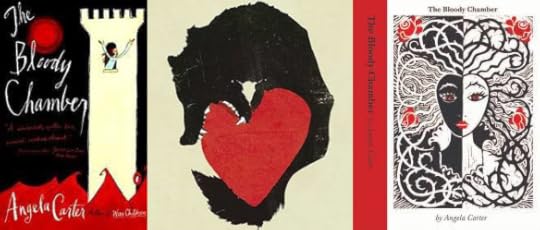
These tales unfold layer by layer, until the heart is revealed. Carter was horrified by the idea that her stories were, as classified by her American publisher, 'fairy tales for adults ' – instead they are reimagining traditional fairy tales, and drawing out the latent. Grandma is the wolf and Beauty can become the beast.
Carter was however, criticised by some commentators for deploying the instrument of the patriarchy, thus still being party to it. I don't agree – turning well-loved fairy tales on their heads clearly reveals the mechanisms of the patriarchy exposing women's unequal status, which even extends to their being bereft of their own sexuality.
One of the reasons I love The Lady of the House of Love so much is that vampire stories are so hard to get right, mainly because it’s such a crowded genre. But Angela Carter delivered something original and new. The story started life as a BBC radio play called Vampirella (1975) and was adapted especially for the collection. Its strength lay in the mix of fairy tale and of horrific folklore.
"A single kiss woke up the Sleeping Beauty in the Wood."
A Gothic interpretation of Sleeping Beauty, it incorporates the traditional tropes; a corrupted bloodline, a beautiful and helpless female and an imposing, decaying castle. She is the end of her line: she is Nosferatu, trapped by a deadly legacy, which she abhors. The external decay of the Castle and everything within replicates the moral degradation of the curse bestowed via her lineage. She's a prisoner in time – waiting for true love's kiss.
Turning the unchanging tarot her question is – can she change and become human? Can she escape her dreadful destiny?
"In her dream, she would like to be human; but she does not know if that is possible."
Then our hero arrives.
As well as The Bloody Chamber, Angela Carter published three other volumes of short stories; Fireworks (1974), Black Venus (1985) and American Ghosts And Old World Wonders (1993, Posthumus). Although The Bloody Chamber is the most celebrated I would urge you to read all four. Black Venus is to my mind equally interesting and worthy of investigation. Do give the three volumes of fairytales she edited a go too – you will not be disappointed; Wayward Girls and Wicked Women – a collection of short stories (1986), The Virago Book of Fairy Tales (1990) and, The Second Virago Book of Fairy Tales (1992)
In no way do I see the short stories as a lesser alternative, but her novels show how she developed as a writer. She moves through genres from murder mystery, science fiction, fantasy to Gothic fairy tale. Her last two novels, Nights at the Circus (1985) and Wise Children (1991) are often cited as the most accomplished and certainly explore the idea of women as performers. Born of a society dominated by the patriarchy, her outrageous characters demonstrate clearly that women are always performing and that their true identity is often masked.
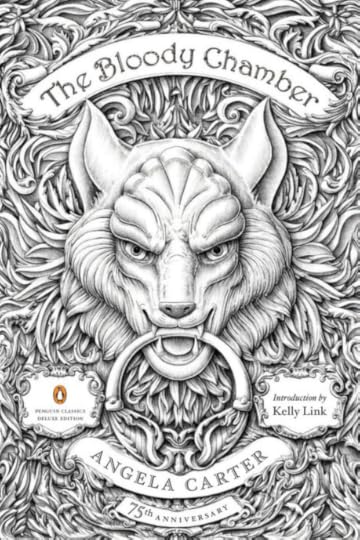
I was glad to be reminded of how easy it is fall back into unhealthy ways of thinking and live as some kind of distorted Disney Princess – no, thank you. I want to live, free, even if that makes me a witch – warts and all.
Angela Carter: Of Wolves and Women (2018), BBC documentary
Next to feature on the Supper Club: Fireside Reflections – I'll be chewing over our meeting with Robert Shearman. Yes, he was actually here with us and shared all his secrets about his fabulously disturbing story, Custard Cream, writing for Doctor Who and his epic Arabian nights style adventure, We All Hear Stories in the Dark.
The Short Story Supper Club is hosted by Racontesse and Kensington and Chelsea Libraries. For more wonderful KCL events subscribe to their newsletter.
Twitter: @rbkclibraries
The Short Story Supper Club: Fireside Reflections 2
The Lady of the House of Love
by
Angela Carter
Fancy a bite?

The Supper Club is here to convince readers that the short story is a mighty feast, imbued with complex flavours and the third sitting was a Gothic banquet.
Thank you to everyone who came to sup and share bonhomie at our table. Apologies for the sound issues during the first 10 minutes and we hope it didn't ruin your overall enjoyment of the event. We appreciate and agree that the balance of biographical information and story detail was a little out of kilter – in the future, we will be sure to keep the short story as the star.
For those of you who couldn't join in or just want more, come sit by the fire with us….
My first encounter with the Queen of the vampires was one of confusion. There was a damsel in distress dreaming of a different life and there was a hero. A hero who was everything a hero is supposed to be, young, strong and surrounded with a halo of golden sunlight.
Where then, was my happily ever after?

Whilst reading Edmund Gordon's biography of Angela Carter, The Invention of Angela Carter: A Biography, the ideas felt familiar almost like waking up memories from my childhood. It's only as I have studied and read and matured that I realised I was (old habits die hard) as indoctrinated by the patriarchy as the next woman. Now I understand that we, as women can create our own happy endings, self save and carve our own path. And for me, Angela Carter's, The Bloody Chamber (1979) was part of my own enlightenment.
"Can a bird sing only the song it knows or can it learn a new song?"
The Lady of the House of Love by Angela Carter was first published in 1979 as part of the celebrated and ground-breaking short story collection, The Bloody Chamber. Both a critical and commercial success, it won the coveted Cheltenham Festival Literary Prize (1979). The chambers of the title are the spaces in which the characters are physically and metaphorically imprisoned, robbed of their agency. In the traditional telling, Carter's main reference was the fairytales of Charles Perrault (1628–1703), the protagonist would have no way of escape, but in Carter's stories the characters often find escape from violence or a traditional marriage.

These tales unfold layer by layer, until the heart is revealed. Carter was horrified by the idea that her stories were, as classified by her American publisher, 'fairy tales for adults ' – instead they are reimagining traditional fairy tales, and drawing out the latent. Grandma is the wolf and Beauty can become the beast.
Carter was however, criticised by some commentators for deploying the instrument of the patriarchy, thus still being party to it. I don't agree – turning well-loved fairy tales on their heads clearly reveals the mechanisms of the patriarchy exposing women's unequal status, which even extends to their being bereft of their own sexuality.
One of the reasons I love The Lady of the House of Love so much is that vampire stories are so hard to get right, mainly because it’s such a crowded genre. But Angela Carter delivered something original and new. The story started life as a BBC radio play called Vampirella (1975) and was adapted especially for the collection. Its strength lay in the mix of fairy tale and of horrific folklore.
"A single kiss woke up the Sleeping Beauty in the Wood."
A Gothic interpretation of Sleeping Beauty, it incorporates the traditional tropes; a corrupted bloodline, a beautiful and helpless female and an imposing, decaying castle. She is the end of her line: she is Nosferatu, trapped by a deadly legacy, which she abhors. The external decay of the Castle and everything within replicates the moral degradation of the curse bestowed via her lineage. She's a prisoner in time – waiting for true love's kiss.
Turning the unchanging tarot her question is – can she change and become human? Can she escape her dreadful destiny?
"In her dream, she would like to be human; but she does not know if that is possible."
Then our hero arrives.
As well as The Bloody Chamber, Angela Carter published three other volumes of short stories; Fireworks (1974), Black Venus (1985) and American Ghosts And Old World Wonders (1993, Posthumus). Although The Bloody Chamber is the most celebrated I would urge you to read all four. Black Venus is to my mind equally interesting and worthy of investigation. Do give the three volumes of fairytales she edited a go too – you will not be disappointed; Wayward Girls and Wicked Women – a collection of short stories (1986), The Virago Book of Fairy Tales (1990) and, The Second Virago Book of Fairy Tales (1992)
In no way do I see the short stories as a lesser alternative, but her novels show how she developed as a writer. She moves through genres from murder mystery, science fiction, fantasy to Gothic fairy tale. Her last two novels, Nights at the Circus (1985) and Wise Children (1991) are often cited as the most accomplished and certainly explore the idea of women as performers. Born of a society dominated by the patriarchy, her outrageous characters demonstrate clearly that women are always performing and that their true identity is often masked.

I was glad to be reminded of how easy it is fall back into unhealthy ways of thinking and live as some kind of distorted Disney Princess – no, thank you. I want to live, free, even if that makes me a witch – warts and all.
Angela Carter: Of Wolves and Women (2018), BBC documentary
Next to feature on the Supper Club: Fireside Reflections – I'll be chewing over our meeting with Robert Shearman. Yes, he was actually here with us and shared all his secrets about his fabulously disturbing story, Custard Cream, writing for Doctor Who and his epic Arabian nights style adventure, We All Hear Stories in the Dark.
The Short Story Supper Club is hosted by Racontesse and Kensington and Chelsea Libraries. For more wonderful KCL events subscribe to their newsletter.
Twitter: @rbkclibraries
New fiction: Kinky To Boot by Sarah Gray

You go to New York, you take in a show. Kinky Boots – we’re two girls on the town tempted to see just how 'kinky' these boots are.
As I cling to the ornate ironwork of the beautiful staircase, Kinky Boots appears painfully ill-fitting. New York's oldest theatre is exquisite, but ‘sans ascenseur’. At the final moment my waif of a sister grabs hold of my flailing arm and yanks hard, only just stopping me plummeting downwards to my demise. We battle to hold our precarious position and watch my stick bounce, somersaulting to the ground narrowly missing innocent theatregoers. Eyes are on us. Sweat loosens my grip. Then, to my absolute surprise, from behind a man shoves his arm between my legs – this is a new experience – hoist by my own vagina.
And New York is delightful with its door attendants and taxi drivers fawning over me to make my bucket list trip perfect.
"You girls sure are pretty – have a nice day!"
Until the theatre stairs.
Standing at the bottom, I look up. Everest would be less intimidating. But hell yeah, I can do this…
Slowly does it, using handrail and stick I incrementally ascend, stair by stair.
Gasping all three, our tongues hanging out like a Golden-Retriever’s, we finally collapse at the summit, applauded by a gaggle of flushed face ushers. Mr 'Me Too' wrenches me up by the arms, placing me upright on solid ground. I wobble, Mr MT's hand shoots out –a universal sharp intake of breath. Two attendant ushers sweep in and escort us to plush blue velvet seats, centre row. Exceeding our meagre budget.
Oh! But what a performance! What a show! Although being part of the ensemble wasn't quite the 'kinky' experience I had expected, to boot.
The Short Story Supper Club - More new fiction
Kinky To Boot?
By Sarah Gray

You go to New York, you take in a show. Kinky Boots – we’re two girls on the town tempted to see just how 'kinky' these boots are.
As I cling to the ornate ironwork of the beautiful staircase, Kinky Boots appears painfully ill-fitting. New York's oldest theatre is exquisite, but ‘sans ascenseur’. At the final moment my waif of a sister grabs hold of my flailing arm and yanks hard, only just stopping me plummeting downwards to my demise. We battle to hold our precarious position and watch my stick bounce, somersaulting to the ground narrowly missing innocent theatregoers. Eyes are on us. Sweat loosens my grip. Then, to my absolute surprise, from behind a man shoves his arm between my legs – this is a new experience – hoist by my own vagina.
And New York is delightful with its door attendants and taxi drivers fawning over me to make my bucket list trip perfect.
"You girls sure are pretty – have a nice day!"
Until the theatre stairs.
Standing at the bottom, I look up. Everest would be less intimidating. But hell yeah, I can do this…
Slowly does it, using handrail and stick I incrementally ascend, stair by stair.
Gasping all three, our tongues hanging out like a Golden-Retriever’s, we finally collapse at the summit, applauded by a gaggle of flushed face ushers. Mr 'Me Too' wrenches me up by the arms, placing me upright on solid ground. I wobble, Mr MT's hand shoots out –a universal sharp intake of breath. Two attendant ushers sweep in and escort us to plush blue velvet seats, centre row. Exceeding our meagre budget.
Oh! But what a performance! What a show! Although being part of the ensemble wasn't quite the 'kinky' experience I had expected, to boot.
March 8, 2021
Fireside Reflections: The Heart of a Heartless World by Sarah Gray
A Second Helping…
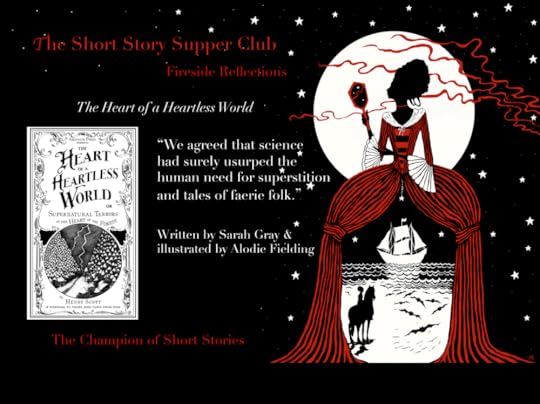
The Supper Club is here to convince readers that the short story is a mighty feast, imbued with complex flavours and the second sitting was a triumph.
Thank you to everyone who came to sup and share bonhomie at our table. We appreciated all of your generous comments and useful suggestions.
For those of you who couldn't join us, come sit by the fire with us…
Wow! This week really was a feast for the eyes. We were all enthralled as the brilliantly creative artist Alodie Fielding opened her sketchbook and allowed us a peek at her process. Alodie and I have collaborated on all three of my short story collections with beautiful results, so it was an absolute thrill sharing in her inspirations at the Short Story Supper Club.
Before we got to rifle through Alodie's sketchbook, she enlightened us with a brief history of the illustrated story. It all started with chapbooks. These became popular in the 1500s and remained so until the 19th century. They were usually roughly-made 40 page pamphlets, which shared all manner of content from children's stories to bawdy songs and gossip. Often they included a wonderful, if crudely rendered, woodcut.
Samuel Pepys (1633 - 1703) was an avid collector of these mischievous and salacious pamphlets with over a 1,000 of them still surviving and inspiring today.

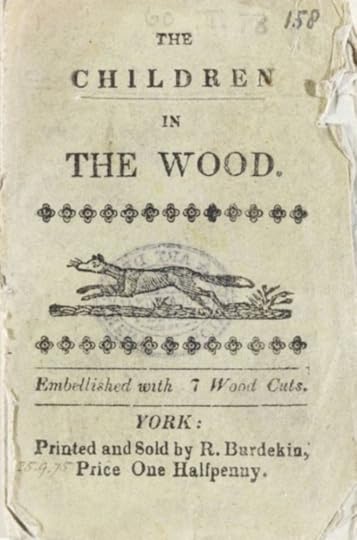
Chapbooks waned in popularity with the rise of The Industrial Revolution. Growing transport networks and literacy levels increasing amongst the poor all contributed to the rapid expansion of book and magazine sales instead.
By the 1800s, there was an incredible variety of work published in a range of formats. One such example is the ‘penny dreadful’. First produced in the 1830s, they took over the mantle from chapbooks with their focus on horror, crime and daring-do. Another prominent example is the work of Charles Dickens whose novels were published in monthly instalments in magazines. He also paved the way for illustrators by being one of the first authors to actually collaborate with an illustrator. Dickens commissioned John Leech to illustrate A Christmas Carol (1843) and it was an enormous success – published on 19 December the first edition sold out by Christmas Eve.
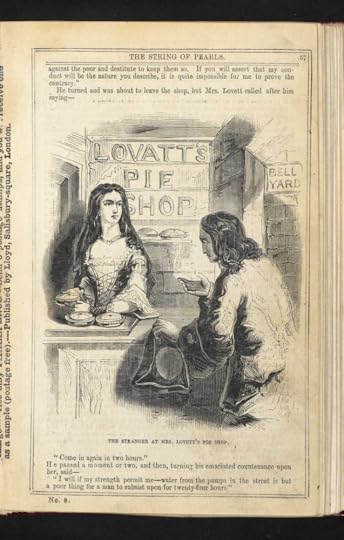
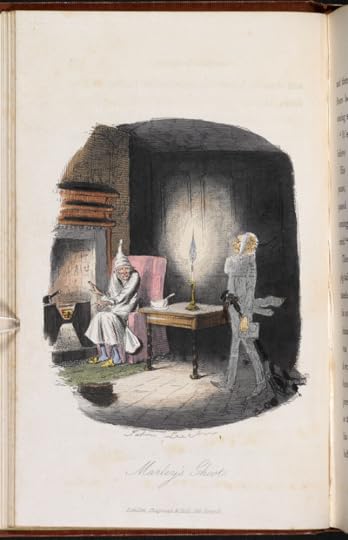
And now back to us…
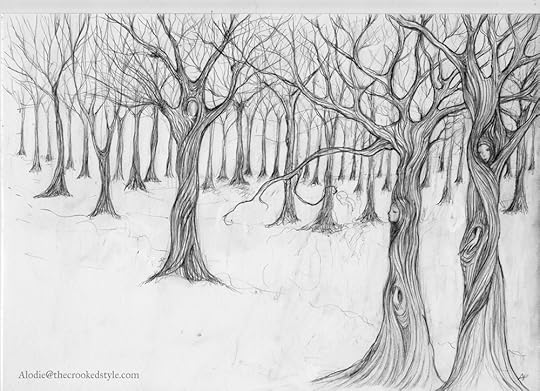

It was a real treat to talk about our ostensibly 'found' Victorian pamphlet, The Heart of the Heartless World, first published in Half Life, (Claret Press, 2016). Written by Henry Scott in 1897 it tells of his near death experience with the supernatural creature, the Skogsrå, at the heart of the deep, dark Scandinavian forests. Incorporating all our shared passions; Gothic imagery, dark, threatening woods and lost souls, it's a wonderful example of how we give rein to our imagination in developing our ideas and making decisions about authenticity.
For HH, we wanted to capture the key moments of the terrors at the heart of the forest. I'm usually quite far into writing the book when I share with Alodie, because it's important I have a clear idea of what the illustrations should convey about the tone, plot and its characters.
After sending Alodie some example images to set the mood and some quotes from the story to give direction, she starts with a pencil drawing. At this stage she is trying to get the composition right. For HH we decided to adopt Victorian style etching to enhance the authenticity. The pamphlet cover itself is the dramatic moment when Henry Scott sees the Swedish coast for the first time. Extreme angles and fork lightning convey danger and mirror Henry's trepidation.
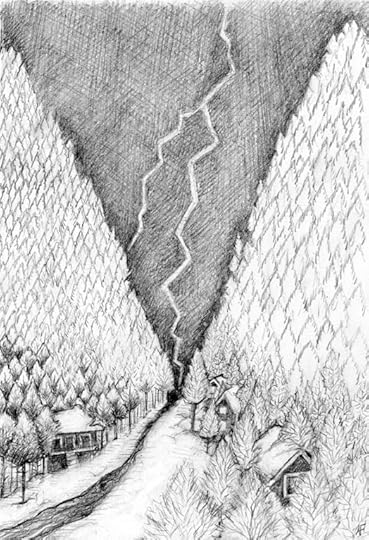
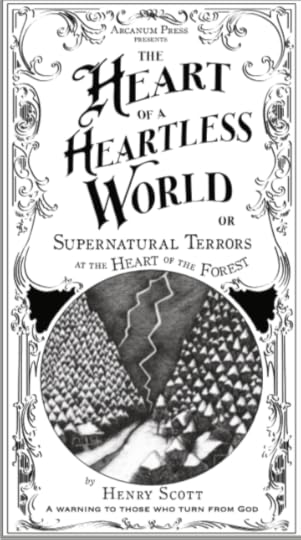
It's also important that illustration and design are harmonious. Alodie works closely with designer Ginny Wood and they make incremental adjustments until both components work together.
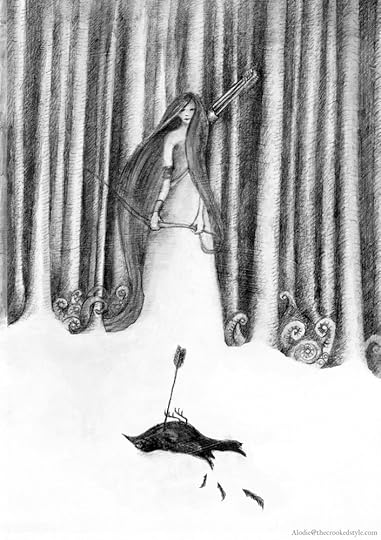
I became obsessed with the folklore of Scandinavia on visits to my Swedish friend and Supper Club co-producer, Josephine. Living deep in the countryside, her house firmly nestling in the woods was both exhilarating and terrifying. I imagined figures standing amongst the trees observing our human habits, waiting to steal our souls. On first seeing the Northern Lights twisting and mutating, pink and green fingers reaching over us, the only lights in an otherwise pitch black sky, I could well believe that supernatural creatures make their home in the forest.
Skogsrå are emotional vampires who drain humans of their life force, leaving them as lonely ghosts wandering the forests. Most northern European countries have a version. In England they are underwhelmingly referred to as ‘woodland nymphs’ – absolutely terrifying, I think you'll agree. In some stories they are said to have wooden hollows in their backs and in others foxtails. This is the feature we emphasised in our interpretation. Our Skogsrå’s hair becomes a sleek tail, reaching to the ground, keeping her perfectly balanced and in harmony with nature.
I like to think that Racontesse are the inheritors of a long tradition of illustrated stories, going back to the chapbook and the penny dreadful.
With The Heart of a Heartless World we have told the first tale of an exciting story world. Watch out for the spring/summer launch of Heartwood and come with us to let us lead you into the deep, dark heart of the forest.
We are so grateful to Alodie and all of you for joining us last time. Be sure to pull up a chair by the Supper Club fire next time… on the menu, The Lady of the House of Love by Angela Carter, 16 March.
We'll talk all things, Angela Carter. Carter's short story collection, The Bloody Chamber (1979) is often cited as some of her most accomplished writing.
My absolute favourite story in the collection is The Lady of the House of Love which introduces us to a vampire. She's the last of her line and preys on the blood of any young man who happens to wander into her village. Blending and drawing out the Gothic with traditional fairytale, it reinvents Sleeping Beauty with not a spindle to prick but a long sharp tooth.
The Short Story Supper Club is hosted by Racontesse and Kensington and Chelsea Libraries. For more wonderful KCL events subscribe to their newsletter.
Twitter: @rbkclibraries
The Heart of a Heartless World
A Second Helping…

The Supper Club is here to convince readers that the short story is a mighty feast, imbued with complex flavours and the second sitting was a triumph.
Thank you to everyone who came to sup and share bonhomie at our table. We appreciated all of your generous comments and useful suggestions.
For those of you who couldn't join us, come sit by the fire with us…
Wow! This week really was a feast for the eyes. We were all enthralled as the brilliantly creative artist Alodie Fielding opened her sketchbook and allowed us a peek at her process. Alodie and I have collaborated on all three of my short story collections with beautiful results, so it was an absolute thrill sharing in her inspirations at the Short Story Supper Club.
Before we got to rifle through Alodie's sketchbook, she enlightened us with a brief history of the illustrated story. It all started with chapbooks. These became popular in the 1500s and remained so until the 19th century. They were usually roughly-made 40 page pamphlets, which shared all manner of content from children's stories to bawdy songs and gossip. Often they included a wonderful, if crudely rendered, woodcut.
Samuel Pepys (1633 - 1703) was an avid collector of these mischievous and salacious pamphlets with over a 1,000 of them still surviving and inspiring today.


Chapbooks waned in popularity with the rise of The Industrial Revolution. Growing transport networks and literacy levels increasing amongst the poor all contributed to the rapid expansion of book and magazine sales instead.
By the 1800s, there was an incredible variety of work published in a range of formats. One such example is the ‘penny dreadful’. First produced in the 1830s, they took over the mantle from chapbooks with their focus on horror, crime and daring-do. Another prominent example is the work of Charles Dickens whose novels were published in monthly instalments in magazines. He also paved the way for illustrators by being one of the first authors to actually collaborate with an illustrator. Dickens commissioned John Leech to illustrate A Christmas Carol (1843) and it was an enormous success – published on 19 December the first edition sold out by Christmas Eve.


And now back to us…


It was a real treat to talk about our ostensibly 'found' Victorian pamphlet, The Heart of the Heartless World, first published in Half Life, (Claret Press, 2016). Written by Henry Scott in 1897 it tells of his near death experience with the supernatural creature, the Skogsrå, at the heart of the deep, dark Scandinavian forests. Incorporating all our shared passions; Gothic imagery, dark, threatening woods and lost souls, it's a wonderful example of how we give rein to our imagination in developing our ideas and making decisions about authenticity.
For HH, we wanted to capture the key moments of the terrors at the heart of the forest. I'm usually quite far into writing the book when I share with Alodie, because it's important I have a clear idea of what the illustrations should convey about the tone, plot and its characters.
After sending Alodie some example images to set the mood and some quotes from the story to give direction, she starts with a pencil drawing. At this stage she is trying to get the composition right. For HH we decided to adopt Victorian style etching to enhance the authenticity. The pamphlet cover itself is the dramatic moment when Henry Scott sees the Swedish coast for the first time. Extreme angles and fork lightning convey danger and mirror Henry's trepidation.


It's also important that illustration and design are harmonious. Alodie works closely with designer Ginny Wood and they make incremental adjustments until both components work together.

I became obsessed with the folklore of Scandinavia on visits to my Swedish friend and Supper Club co-producer, Josephine. Living deep in the countryside, her house firmly nestling in the woods was both exhilarating and terrifying. I imagined figures standing amongst the trees observing our human habits, waiting to steal our souls. On first seeing the Northern Lights twisting and mutating, pink and green fingers reaching over us, the only lights in an otherwise pitch black sky, I could well believe that supernatural creatures make their home in the forest.
Skogsrå are emotional vampires who drain humans of their life force, leaving them as lonely ghosts wandering the forests. Most northern European countries have a version. In England they are underwhelmingly referred to as ‘woodland nymphs’ – absolutely terrifying, I think you'll agree. In some stories they are said to have wooden hollows in their backs and in others foxtails. This is the feature we emphasised in our interpretation. Our Skogsrå’s hair becomes a sleek tail, reaching to the ground, keeping her perfectly balanced and in harmony with nature.
I like to think that Racontesse are the inheritors of a long tradition of illustrated stories, going back to the chapbook and the penny dreadful.
With The Heart of a Heartless World we have told the first tale of an exciting story world. Watch out for the spring/summer launch of Heartwood and come with us to let us lead you into the deep, dark heart of the forest.
We are so grateful to Alodie and all of you for joining us last time. Be sure to pull up a chair by the Supper Club fire next time… on the menu, The Lady of the House of Love by Angela Carter, 16 March.
We'll talk all things, Angela Carter. Carter's short story collection, The Bloody Chamber (1979) is often cited as some of her most accomplished writing.
My absolute favourite story in the collection is The Lady of the House of Love which introduces us to a vampire. She's the last of her line and preys on the blood of any young man who happens to wander into her village. Blending and drawing out the Gothic with traditional fairytale, it reinvents Sleeping Beauty with not a spindle to prick but a long sharp tooth.
The Short Story Supper Club is hosted by Racontesse and Kensington and Chelsea Libraries. For more wonderful KCL events subscribe to their newsletter.
Twitter: @rbkclibraries
March 5, 2021
New Fiction: Mothers' Nature
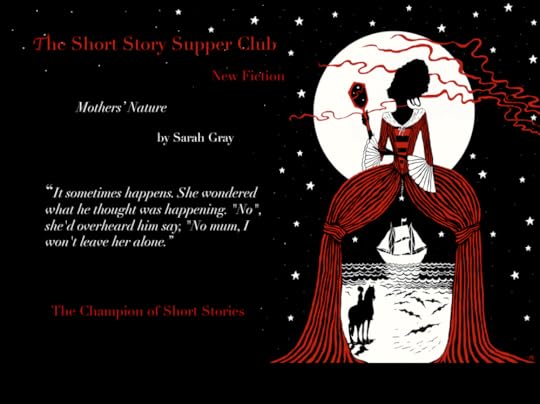
The husband gloated with every kiss he bestowed upon the tiny boy's head.
"Smells delicious, like warm milk or a summer peach. I could gobble him up." His eyes closed, he nuzzled into the baby's neck making smacking noises as if devouring it. Overpowered by its stench, she gagged, nearly retching from the bottom of her stomach.
Past were the aromas of her childhood; rotting leaves, moist earth, decayed fungus.
People had said when she saw the baby she'd love it. Deeply and unconditionally, "There's a bond between mother and baby that doesn't even come close to any other relationship. Not even near." The mother-in-law cawed. In response, the son engulfed her with 'one of his hugs'. In return, she rewarded him with an exaggerated peck on the cheek.
"It'll get easier." The husband said, pulling at the nappy. Chubby legs kicked back and forth, attempting to evade the procedure. "It sometimes happens, don't blame yourself."
It sometimes happens. She wondered what he thought was happening. "No", she'd overheard him say, "No mum, I won't leave her alone." How could it be avoided, he left her alone almost every day. Customers to visit. "Boilers," he'd assured her, "don't fix themselves."
Today was ideal. Another boiler refusing to mend itself. And no, she didn't need a babysitter. The rain determined, left every surface soaked to a polished shine. As people will, they commiserated with her for the disruption to their outings and one, a man more beast with a hairy face, laughed "Better get that baby back home or it might be washed away!" "Yes", she agreed.
Soon, the crying began.
No longer burdened by the pushchair, she walked with a languorous step, trawling through the russet leaves and kicking them into the air. She inhaled.
Present were the aromas of her childhood; rotting leaves, moist earth, decayed fungus.
This was the only thing to do she congratulated herself. She couldn't return, but everyone deserves a good mother. Hers would take perfect care of him.
Future are the aromas of her childhood; rotting leaves, moist earth, decayed fungus.
The crying receded, becoming smaller with her increasing distance.
New Fiction: Mothers' Nature by Sarah Gray

The husband gloated with every kiss he bestowed upon the tiny boy's head.
"Smells delicious, like warm milk or a summer peach. I could gobble him up." His eyes closed, he nuzzled into the baby's neck making smacking noises as if devouring it. Overpowered by its stench, she gagged, nearly retching from the bottom of her stomach.
Past were the aromas of her childhood; rotting leaves, moist earth, decayed fungus.
People had said when she saw the baby she'd love it. Deeply and unconditionally, "There's a bond between mother and baby that doesn't even come close to any other relationship. Not even near." The mother-in-law cawed. In response, the son engulfed her with 'one of his hugs'. In return, she rewarded him with an exaggerated peck on the cheek.
"It'll get easier." The husband said, pulling at the nappy. Chubby legs kicked back and forth, attempting to evade the procedure. "It sometimes happens, don't blame yourself."
It sometimes happens. She wondered what he thought was happening. "No", she'd overheard him say, "No mum, I won't leave her alone." How could it be avoided, he left her alone almost every day. Customers to visit. "Boilers," he'd assured her, "don't fix themselves."
Today was ideal. Another boiler refusing to mend itself. And no, she didn't need a babysitter. The rain determined, left every surface soaked to a polished shine. As people will, they commiserated with her for the disruption to their outings and one, a man more beast with a hairy face, laughed "Better get that baby back home or it might be washed away!" "Yes", she agreed.
Soon, the crying began.
No longer burdened by the pushchair, she walked with a languorous step, trawling through the russet leaves and kicking them into the air. She inhaled.
Present were the aromas of her childhood; rotting leaves, moist earth, decayed fungus.
This was the only thing to do. She congratulated herself. She couldn't return, but everyone deserves a good mother. Hers would take perfect care of him.
Future are the aromas of her childhood; rotting leaves, moist earth, decayed fungus.
The crying receded, becoming smaller with her increasing distance.
February 9, 2021
New Fiction: Any Spare Change? by Sarah Gray
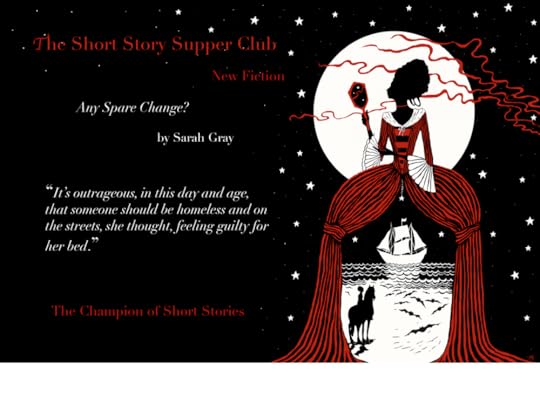
‘Any spare change?’ he pleaded. An impish sort of man wearing oversized clothing sat on the pavement, a cap laid out in front of him. He appeared all the more frail for sitting under the unremittingly large sign of a major supermarket. She hoped this chain donated its out-of-date products to the homeless. She also hoped he’d already collected a decent amount of money that morning. It would be unbearable to see just a few pennies in the bottom of his hat.
People passed him. Some refused to look, some rushed by, embarrassed at the idea they might be caught out by a glance; others tossed in a few coins, and some gave a slight, near-imperceptible nod. It’s outrageous, in this day and age, that someone should be homeless and on the streets, she thought, feeling guilty for her bed. One of her greatest joys was snuggling under the duvet and luxuriating in its warmth and comfort. She wanted to be brave. How could she look him in the face? He might have been urinated on or even beaten. She screwed up her nose.
‘Any spare change?’ Imploring again, he looked up to the busy people hurrying by. What about drugs! Maybe he was an addict; he did look pale. Donating to a homelessness charity was the better option. No! She must be brave. There was at least ten pounds’ worth of change in her purse, she’d give him that. Asking him to help himself would be awkward, but she could manage the discomfort. It was the right thing to do, after all. What if he stole her purse! The unwelcome thought popped into her head. Don’t be ridiculous, she chastised herself.
Approaching him, she prepared to speak in her clearest voice. ‘Excuse me,’ she said. He looked at her. She looked at him. But before she could continue, he lowered his eyes in a fixed stare, seemingly scrutinising his cap. Trying again in a loud voice, she said, ‘Excuse me.’ Turning his head away, he searched the distance – for a friend, perhaps, late for their appointed rendezvous. One last time, she shouted, ‘I have some money for you, in my purse. Take it.’ Still he searched for his tardy friend.
Using her head, she pressed on the control pad of her wheelchair and rolled towards the entrance of the supermarket. From behind she heard a voice, pleading, ‘Any spare change?’



